Ijraset Journal For Research in Applied Science and Engineering Technology
- Home / Ijraset
- On This Page
- Abstract
- Introduction
- Conclusion
- References
- Copyright
A Study on the Properties of High Strength Fiber Reinforced Self Curing Concrete
Authors: Hari Ganesh M, Lavanya G
DOI Link: https://doi.org/10.22214/ijraset.2022.46455
Certificate: View Certificate
Abstract
Curing is the process of maintaining the right moisture level in concrete, especially for the initial 28 days to get the complete cement hydration and the formation of C-S-H gel. The C-S-H gel formation in the concrete is significantly influenced by curing. In most cases, good curing is not practically achievable. Self-curing concrete is one of the unique concretes that aids in reducing inadequate curing caused by human negligence. Self-curing concrete is also used in water-scarce regions. The grade of concrete prepared was M60, and it was tested for its compressive strength, split tensile strength and flexural strength. The cementitious material is partially replaced with silica fume and fly ash by 5% and 10%, respectively. Nylon fiber is also to be introduced in concrete with different ratios like 0.25%, 0.50%, 0.75%, and 1%. This present study aims to determine the most suitable percentage of fiber to be added in high-strength external self-curing concrete so that the loss of strength due to shrinkage crack is reduced and also to improve the impact resistance of the concrete, external self curing compound Concure WB is used in this project for the purpose of curing concrete.
Introduction
I. INTRODUCTION
Even in isolated and arid places, the construction business isexpanding daily. Even India and other nations experience significant difficulties in providing clean drinking water to their inhabitants. Therefore, there is pressure on the construction industry to develop new techniques for curing concrete. In order for concrete to achieve the necessary qualities, curing involves keeping concrete's early phases at a sufficient moisture level. The basic components of concrete are cement paste and aggregate, which are governed by the workability of fresh concrete and the needs for durability and strength based on the curing process.The term "high-strength concrete" refers to concrete that has a specific characteristic cube strength of between 60 and 100 N/mm2. However, in nations like the USA, Germany, Canada, and a number of other countries, greater values have been obtained and applied to both precast and in-situ work.. High-span bridges, columns for tall buildings, offshore construction, and other roadway structures are the principal uses for high-strength concrete in-situ concrete construction. The primary benefit of high-strength concrete is the decrease in necessary longitudinal reinforcement and/or compression element size. The processes and technology needed to produce high-strength concrete aren't all that dissimilar from those used to produce standard-strength concrete.
II. MATERIALS USED
A. Cement.
Cement is a substance that is frequently used in the building industry to bind concrete. It is a material that can be described as providing adhesive and cohesive qualities that enable it to bind material pieces into a compact mass. In the investigation, ordinary Portland cement of 53 grade was used.
TABLE ?
PROPERTIES OF CEMENT
|
S.No |
Property |
Test result |
|
1. |
Specific gravity |
3.12 |
|
2. |
Initial and final setting time (min) |
30 min and 60 min |
|
3. |
Fineness (%) |
2.5% |
B. Fine Aggregate.
River sand is replaced by manufactured sand (M-Sand) for making concrete. Crushing hard granite stone yields manufactured sand. The crushed sand is graded, rinsed, and shaped into a cubical shape with grounded edges for use in construction. M-Sand is manufactured sand with a particle size of less than 4.75mm. In this experiment, M-sand is used.
C. Coarse Aggregates.
In the experimental investigation, the aggregates that retrained on a 4.75 mm sieve (referred to as coarse aggregates) were used. These aggregates typically consist of crushed stones that are 20 mm in size. The crushed stone aggregates used were nominally no larger than 20 mm and were examined in accordance with Indian standards. The specific gravity of the coarse aggregates used in this investigation is 2.62.
D. Water.
Water takes the main part in the hydration of cement. Because it contributes to the strength of the C-S-H gel via chemical reaction, the quantity and quality of water must be carefully considered. Pure potable water is used for mixing.
E. Fly ash.
Fly ash, a byproduct of burning pulverised coal that is finely divided, is removed from the combustion chamber by exhaust gases. The particles are glassy and spherical when compared to cement particles. It is a pozzolanic substance that, when mixed with free lime in the presence of water, produces C-S-H gel, the substance that makes up the concrete paste that is the strongest and most durable. High calcium ASTM class C fly ash was used in this experiment. The specific gravity of the fly ash used in this investigation was 2.2.
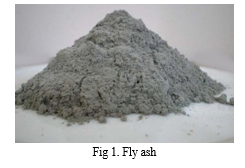
F. Silica fume.
The smelting process used in the silicon and ferrosilicon industries produces microsilica, a by-product. Noncrystalline silica is commonly found in byproducts of silicon metal manufacturing and ferrosilicon alloys with silicon concentrations of 75% or higher. Micro silica is sometimes referred to as silica dust, volatilized silica, condensed micro silica, or micro silica. Compressive strengths in the order of 60–150 MPa are reasonably simple to generate in laboratories by combining microsilica and superplasticizers. By reducing permeability, fine-tuning the pore structure to prevent the diffusion of detrimental ions, and lowering the calcium hydroxide concentration, the addition of micro silica to concrete increases the longevity of the material and increases resistance to sulphate assault.

G. Nylon fiber.
The strength of nylon does not diminish with time and it has good tenacity. The strength-to-weight ratio of nylon is excellent. One of the lightest and strongest textile fibers available. The abrasion resistance of nylon is excellent. The nylon fiber is used in this experiment in various ratios, and its properties are listed below.
TABLE ?
PROPERTIES OF NYLON FIBER
|
1 |
Length of fiber |
1.5 inch |
|
2 |
Resistance to salt & acid |
Good |
|
3 |
Colour |
White |
|
4 |
Tensile strength |
300 Mpa |
|
5 |
UV resistance |
High |
|
6 |
Resistance to alkali |
Excellent |
|
7 |
Specific gravity |
1.15 |
|
8 |
Diameter |
0.33mm |
|
9 |
Material
|
100% virgin fiber
|

H. Super plasticizer.
In this experiment, sikacim pink works as a superplasticizer. Without adding more water, it is becoming more workable. Sikacim Pink is a super plasticizer with a polycarboxylate ether basis. The properties of the super plastiziers used in these experiments are colour-pink, density-1.21 @25 c and ph value is 7.
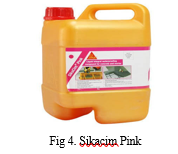
III. EXPERIMENTAL INVESTIGATION.
A. Experimental setup.
M60 concrete was used in our study to cast the cube and cylinder specimens. This study is concerned with adding nylon fiber in ratios like 0.25%, 0.50%, 0.75%, and 1% to the concrete mix. Cubes and cylinders are used, respectively, to measure compressive strength and split tensile strength. The following test is to be conducted to find the optimum proportions of nylon fiber in external self-curing concrete.
B. Casting
Standard cube specimens with dimensions of 150 mm x 150 mm x 150 mm, cylinder specimens with dimensions of 150 mm in diameter and 300 mm in height for split tensile strength tests, and flexural beam strength test specimens was cast. The samples were kept in relatively moist air and away from vibration during the curing time at room temperature. After two days, the cast specimen is demoulded and labelled with a sign for further identification.
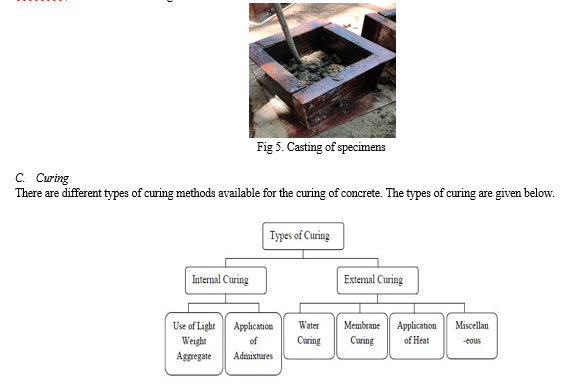
In this study, the membrane curing or self-curing type is done, and the self-curing compound used in this project is Concure WB. Concure WB is an alkali reactive, low viscosity wax emulsion. This technique makes sure that the emulsion instantly degrades to form a non-penetrating continuous layer upon contact with a surface made of cementitious concrete. By preventing excessive water evaporation, this impermeable coating increases cement hydration efficiency, which reduces shrinkage and boosts concrete's strength and durability. The membrane will stay on the concrete surface after it has been produced until it eventually erodes and disintegrates due to weathering. The membrane that remains after curing may need to be removed by wire brushing or other mechanical means if further treatment on this concrete surface is required.

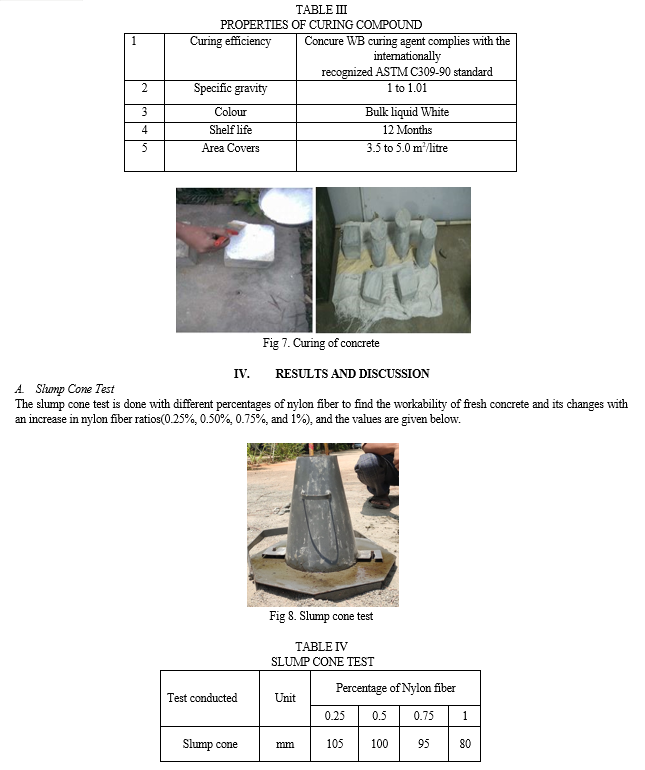
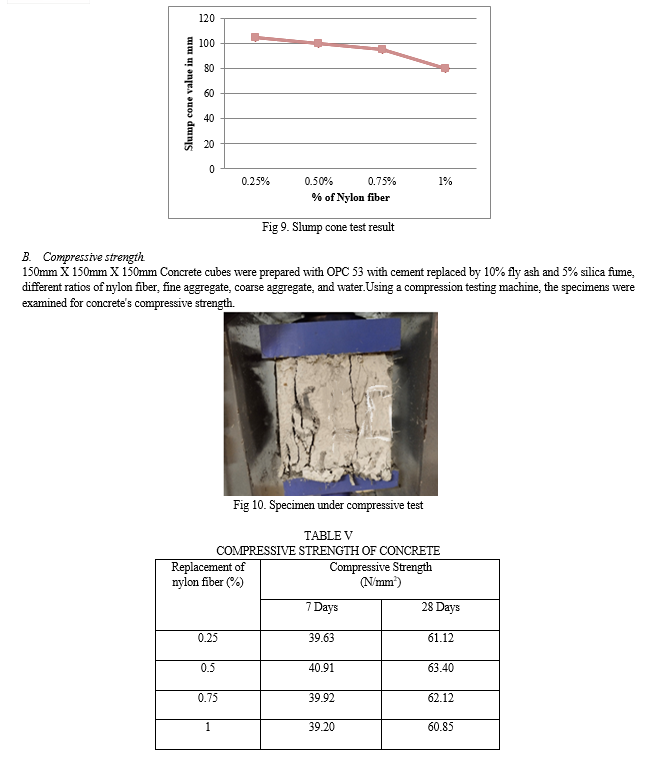
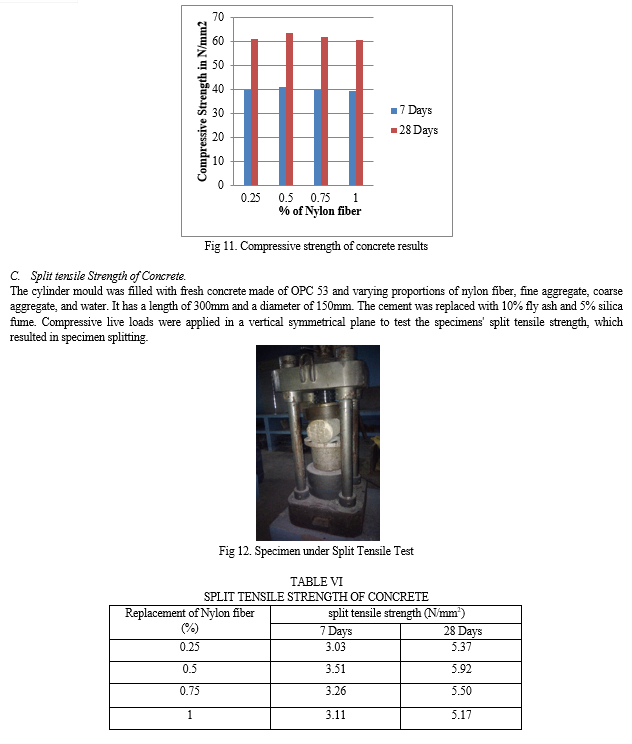


Conclusion
On the basis of the results obtained from the present study, the following conclusions can be drawn, The specimen\'s compressive strength, split tensile strength and flexural strength were greatest when 0.5% nylon fiber was added to external self-curing concrete. The maximum compressive strength of concrete at 28 days was 63.40 N/mm2 ,the maximum spilt tensile strength of concrete at 28 days was 5.92 N/mm2 and the maximum flexural strength of concrete at 28 days was 7.25 N/mm2 and these results were achieved at 0.50% of nylon fiber added in external self-curing concrete. External self-curing concrete is more cost-effective since it does not require curing costs. Spray application lowers labour costs, eliminates the requirement for additional curing systems, and curing chemical increases water retention for self-cured concrete. Compared to regular curing concrete, concrete with a curing chemical produces a smooth, fine finished surface. External self-curing concrete is a solution to the various issues that the construction industry faces related to improper curing, a lack of water in some areas, and the need for an alternative to traditional curing of concrete in desert areas where water scarcity is a big issue.
References
[1] Dr. C. Rajasekaran and Ngirabakunzi Claver (2020) “Comparative study on externalself curing concrete and conventional curing concrete using different binding materials (OPC AND PPC)” World Journal of Engineering Research and Technology Vol. 6, Issue 3, 488-514. ISSN 2454-695X. [2] S.P.Raju.V, Martha Saikumar, T.Srinivasa, G.V.D.N. SaiVamsi, A.Vijaya Srinivas Srikar (2020) “Experimental Study on Compressive Strength, Water Retention And Water Absorption of self-curing Concrete With Different Curing Conditions”E3S Web of Conferences 184, 01118. [3] Aditya Pathak (2020) “Effect of Silica Fume and Fly Ash as Partial Replacement of Cement on Strength of Concrete” International Conference of Advance Research and Innovation . [4] S. Samrose1 and R. Mutsuddy (2019) “Durability of nylon fiber reinforcement concrete” International Conference on Disaster Risk Management, Dhaka, Bangladesh. [5] Alex Tharun P J (2018) “ Experimental Investigation on Strength Properties of Nylon Fiber Reinforced Concrete Pavements”International Journal of Engineering Research & Technology (IJERT) Volume 6, Issue 06,ISSN: 2278-018. [6] E. Siva Subramanian, V.R. Vaishnave, V.T.S Vignesh ( 2016) “Experimental investigation of concrete composite using nylon fiber” ISSN: 2277-9655. [7] Akaram Ali, Aleem Aijaz, Mohammad Arsalan (2018) “A study on nylon fiber reinforced concrete by partial replacement of cement with metakaolin: A literature review” International Research Journal of Engineering and Technology (IRJET) p-ISSN: 2395-0072,e-ISSN: 2395-0056 Volume: 05 Issue: 03 [8] K.Manikandan, A.Arunkumar, M.Deepak kumar, V.Manikandan, K.Sathish kumar (2015) “Experimental investigation on nylon fiber reinforced concrete” (IRJET) p-ISSN: 2395-0072,e-ISSN: 2395 -0056 Volume: 04 Issue: 03, Mar -2017. [9] Mohammed Abdul Samee, Mohammed Abdul Samee, Mohammed Abdul Sabeel Ahmed,Mohammed Kaiser,Mohammed Safiuddin (2017) “Partial Replacement of Cement in Concrete with Fly Ash and Micro Silica” SSRG International Journal of Civil Engineering ( SSRG – IJCE ) – Volume 4 Issue 4. [10] M Hani1, M R Noor Syuhaili, M F Hasmori1 and S M Shahmi (2017) “Effect of nylon fiber on mechanical properties of cement based mortar” IOP Conf. Series: Materials Science and Engineering doi:10.1088/1757-899X/271/1/012080. [11] Ali Alsalman, Canh N. Dang, W. Micah Hale (2017), “Development of ultra-high performance concrete with locally available materials” Construction and Building Materials, vol-133, pp.135–145. [12] D. Pedro, J. de Brito, L. Evangelista (2017), “Evaluation of high-performance concrete with recycled aggregates: Use of densified silica fume as cement replacement” Construction and Building Materials, Vol-47, pp. 803–814. [13] ShashwatSharda, Manvendra Singh, bandSarbjeet Singh (2016), “A review on Properties of Fiber Reinforced Cement-based materials” IOSR Journal of Mechanical and Civil Engineering (IOSR-JMCE) e-ISSN: 2278-1684,p-ISSN: 2320-334X, Volume 13, Issue 5 Ver. I, PP 104-112 [14] Jaya Saxena , Prof. Anil Saxena(2015) “Enhancement the Strength of Conventional Concrete by using Nylon Fiber” Research Inventy: International Journal Of Engineering And Science Vol.5, Issue 2, PP 56-59 Issn (e): 2278-4721, ISSN (p):2319-6483. [15] Vishal Gadgihalli, Ramya M S, Sindu Shankar, Raghavendra Prasad HavanjeDinakar , Babitha Rani H (2017) “Analysis of properties of concrete using nylon fiber as fiber reinforcement admixture”Vol.5 (Iss.4: RASM), ISSN- 2350-0530(O), ISSN- 2394-3629(P) [16] Huaxi LI (2015), “Effects of Silica Fume on Concrete Compressive Strength” Applied Mechanics and Materials,Vol. 744-746, pp.78-81. [17] Akanksha A. Patil*, Prof. M. R. Vyawahare. (2014) \"Comparative study on compressive strength of Self cured SCC and Normally cured SCC.\" Journal of Engineering Research and Applications 2014; 4(11 Version - 5): 139. [18] M. Manoj Kumar and D. Maruthachalam (2013) “Experimental Investigation on Self-curing Concrete”International Journal of Advanced Scientific and Technical Research Issue 3 volume 2,ISSN 2249-9954. [19] M.V.Krishna Rao, P. Rathish Kumar, Azhar M. Khan (2010) “A study on the influence of curing on the strength of a standard grade concrete mix.” Facta universitatis, Architecture and Civil Engineering 2010; 8(1): 23 - 34,DOI: 10.2298/FUACE1001023K . [20] B.W. Langana, K. Wengb, M.A. Warda (2002) “Effect of silica fume and f ly ash on heat of hydration of Portland cement”Cement and Concrete Research 32 (2002) 1045–1051
Copyright
Copyright © 2022 Hari Ganesh M, Lavanya G. This is an open access article distributed under the Creative Commons Attribution License, which permits unrestricted use, distribution, and reproduction in any medium, provided the original work is properly cited.

Download Paper
Paper Id : IJRASET46455
Publish Date : 2022-08-24
ISSN : 2321-9653
Publisher Name : IJRASET
DOI Link : Click Here
 Submit Paper Online
Submit Paper Online

